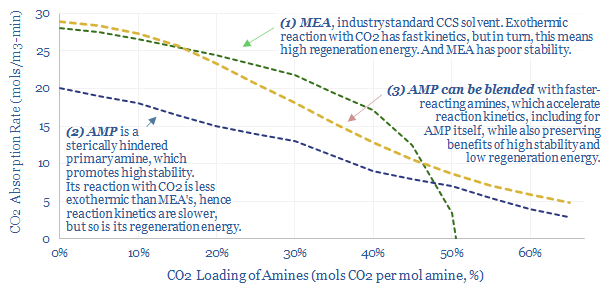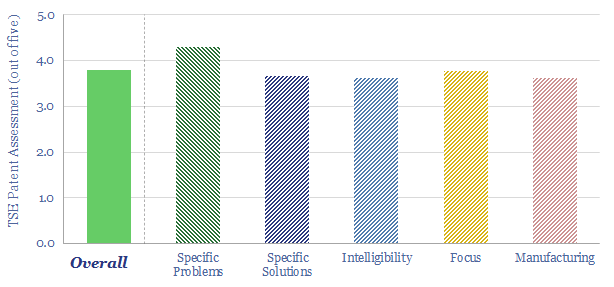Aker Carbon Capture is a public company, listed in Norway, with c120 permanent employees in 2022. It has developed novel solvents for post-combustion carbon capture, with low energy penalties (1.6 GJ/ton) and high stability; plus modular CCS plants using those solvents, such as JustCatch (40-100kTpa scale) and BigCatch (>400kTpa). The company aims to secure contracts for 10MTpa of CCS by 2025. This Aker Carbon Capture technology review looks for a moat in the company’s patents.
Amines used to capture CO2 need to (a) react quickly with CO2 to form carbamates (aka “fast reaction kinetics”) otherwise the plant is overly large and the process is not feasible at scale; (b) have low energy penalties when steam-treating amines so that their CO2 can be re-released for disposal (TSE note here and data-file here); (c) be chemically stable, including low degradation rates (TSE note here); (d) low emissions to air, including for ammonia, amines, but especially for toxic/carcinogenic breakdown products, such as nitrosamines, which ideally will not be generated at all; and (e) have low corrosiveness.
To address these challenges, Aker Carbon Capture states that its technology is derived from Northern Europe’s “largest R&D program” into amines, which tested 90 different solvent cocktails over 8-years, including 60,000 hours of operational testing of a front-runner solution. Based on our patent review, we think there is a moat around its technology.
What is Aker Carbon Capture’s specific technology and solvent cocktail? Several technical papers refer to a blend named “S26”. We think we can guess the underlying components of S26 from this patent screen, and our guesses are spelled out in the data-file. Our patent review also helps us to de-risk Aker Carbon Capture’s claims of high stability and low nitrosamine formation.
How does Aker Carbon Capture’s technology work? We think the high solvent stability mainly comes from steric hindrance around a primary amine at the core of the process. This amine has a relatively less exothermic reaction with CO2 versus other amines, which means low regeneration energy, but also slow reaction kinetics. Reaction kinetics, in turn, are enhanced by blending this core amine with faster-reacting amines (chart below).

Complexity? Aker Carbon Capture AS was formed from the 2014 merger of Advanced Carbon Capture AS and Aker Clean Carbon AS. So the overall patent library contains filings from at least three separate companies.
We think the most important amine patents are in Advanced Carbon Capture’s patent library. The most important challenges tackled in Aker Clean Carbon’s patents are around the balance of plant, avoiding release of amines and amine degradation components, especially as past designs for water wash units have been erratic. Aker Carbon Capture has subsequently re-filed several of these older patents under its own name.
Controversies to explore with the company include future patent expiries, novelty (as other companies’ patents have discussed similar amine blends, albeit not as specifically), energy intensities (which could not be fully de-risked from the patents that crossed our screen) and focus (several patents discuss different solutions and even different sub-industries).
Further details into Aker Carbon Capture technology are set out in the data-file, and in our broader CCS research.
